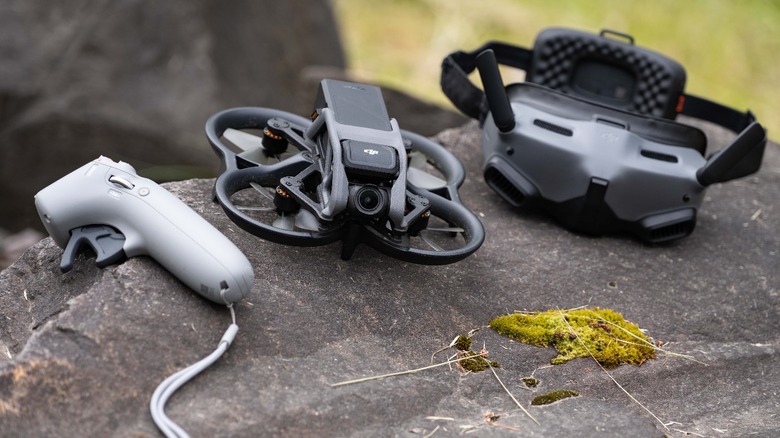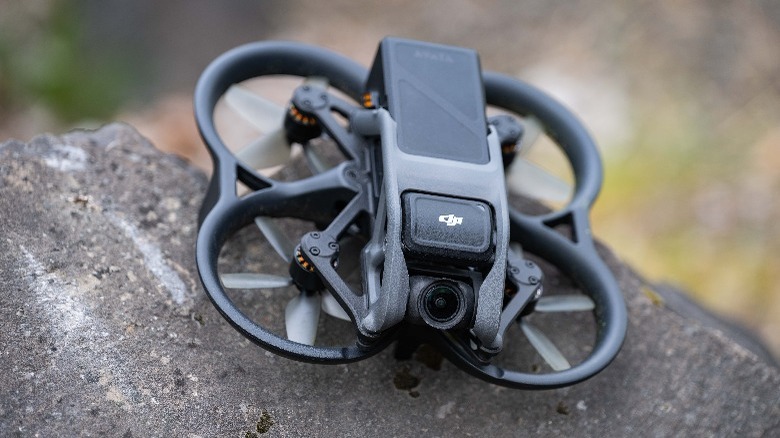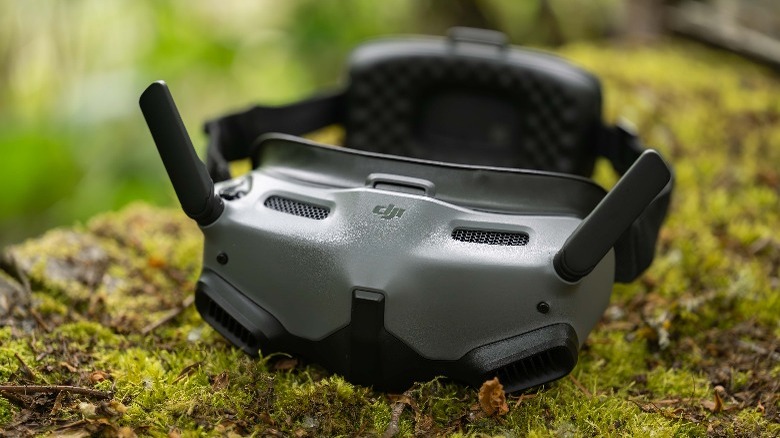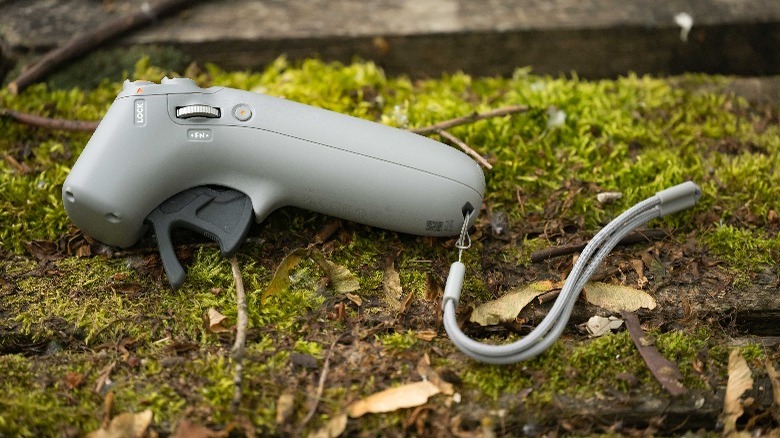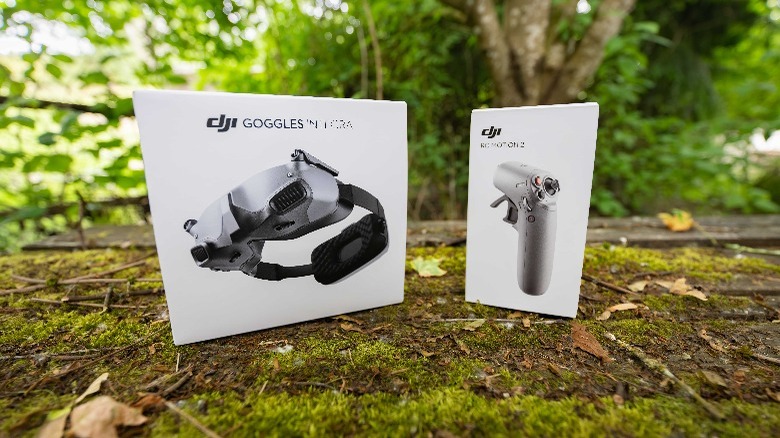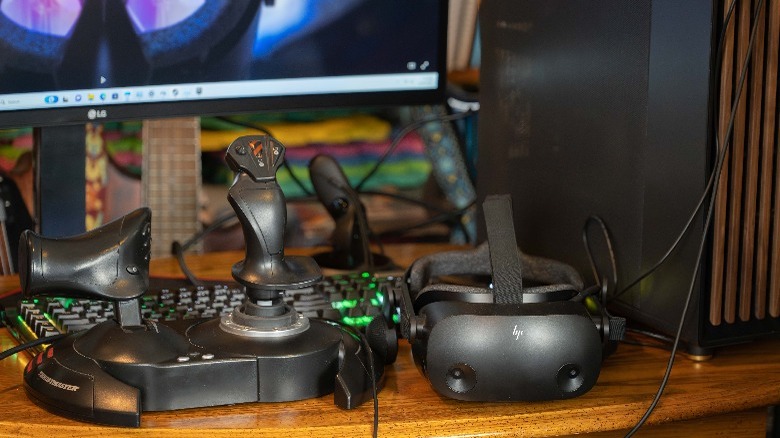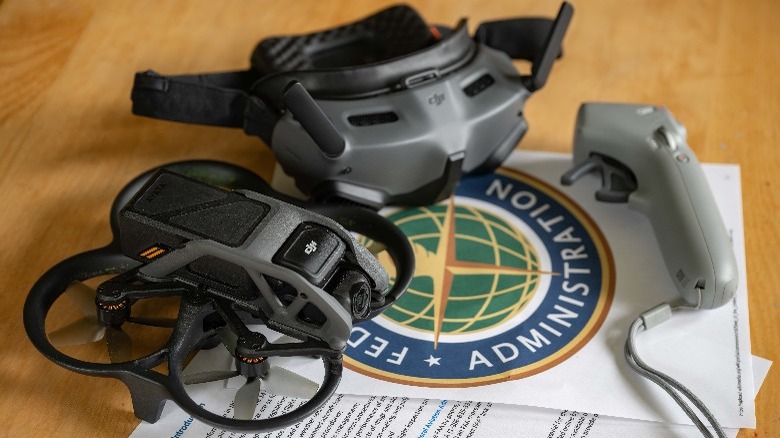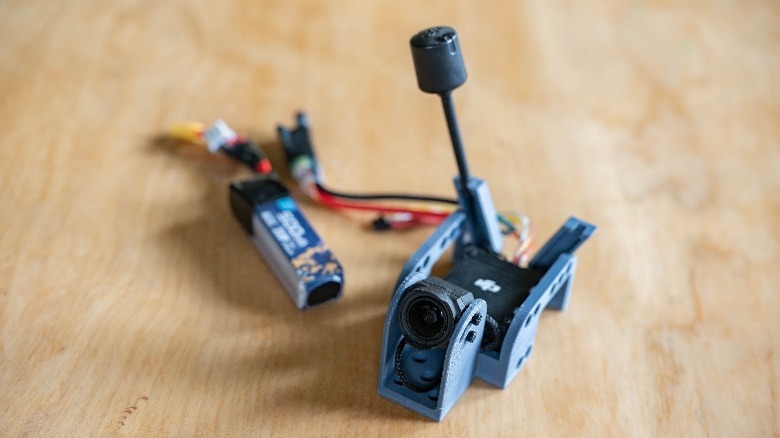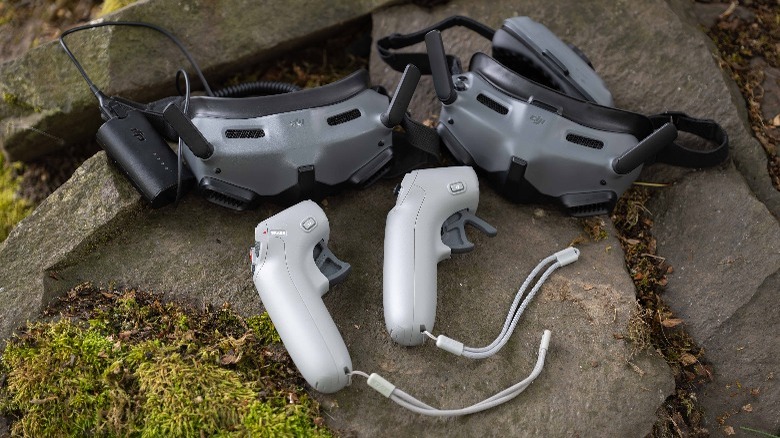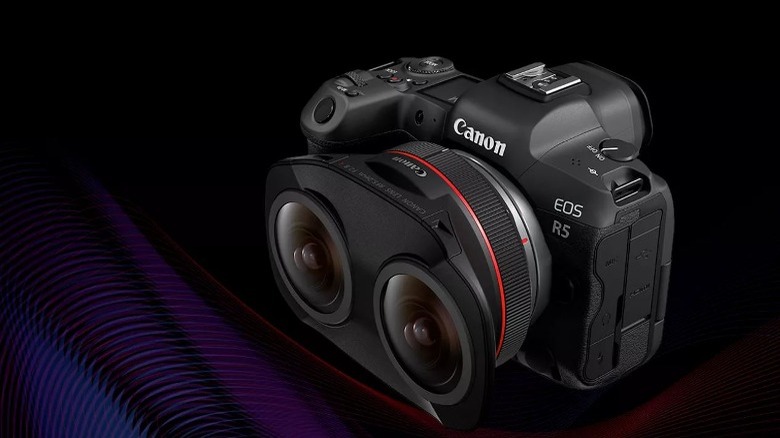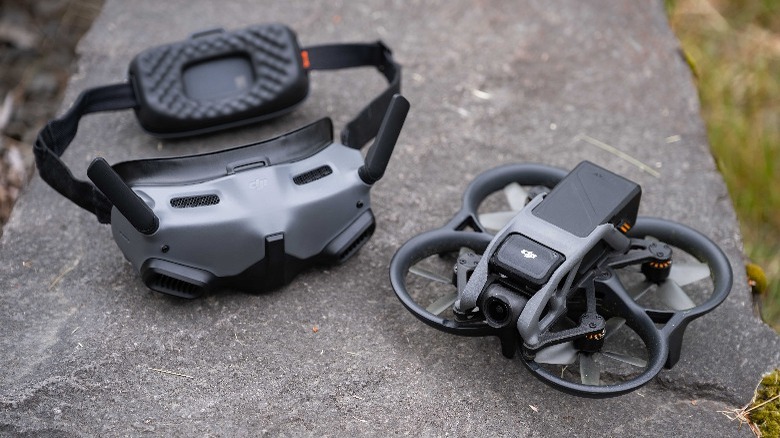Unleash Your Inner Maverick: My Experience With DJI's Immersive New FPV Drone System
One of the best types of experiences to have in virtual reality is in a flight simulator, but even better is to take to the skies for real. DJI's new Goggles Integra and RC Motion 2 controller combine with the intuitive and agile Avata drone to form a system that offers an immersive first-person view (FPV) drone system. Importantly, it makes it much easier for novice pilots to test their virtual wings.
It wasn't long ago that daring and exhilarating FPV headsets were captured mainly using homemade drones controlled by grainy analog headsets and byzantine controllers. Such systems were fully manual as well, and took years to master, with the learning process itself typically resulting in many expensive crashes. The Avata has solved the drawbacks of these rigs with advanced software, as well as intuitive controls and a high-quality digital display. The Goggles Integra and RC Motion 2 promise to make FPV flight even more accessible still.
DJI provided the FPV drone system for the purposes of creating this article.
DJI Avata is an accessible FPV drone system
Where first-person view drone flying was once only available to dedicated hobbyists and required extensive technical knowledge, the DJI Avata makes this exciting style of drone flying accessible to newcomers. Building your own FPV drone is a major undertaking if you lack the know-how and tools to assemble the various components, and even if you buy a pre-built DIY-style FPV drone, you're still diving in at the deep end when it comes to actually flying these machines manually.
With Avata, the most difficult part of the process is getting all the components updated to the latest firmware; while testing, I did run into errors during the initial setup of the drone with the DJI Goggles Integra and Motion 2 Controller. It took a little troubleshooting before the Avata was ready to take off with the new control system. Once that was all sorted out, however, it was smooth sailing. The batteries are easy and safe to charge, as compared to the lipo batteries typically used with DIY FPV builds, which require specialized and technical charging setups, and are somewhat hazardous by comparison.
Goggles Integra feature built-in battery
The DJI Goggles Integra features a heavily padded battery pack built into the rear strap and a new fit adjustment system which is tightened and loosened via a knob on the rear of the battery pack. Previous DJI FPV goggles required plugging a battery into a long cord. This was awkward and had a tendency to become tangled, caught on objects, or accidentally disconnected. The new battery pack is much more convenient and secure, though it does add extra weight to your head.
The optics and display of the Goggles Integra feature the same micro-OLED 100 Hz displays as the DJI Goggles 2, which enable highly precise and immersive navigation, though the field of view has been slightly decreased. A major change is that rather than adjustable diopters, the Goggles Integra includes a set of interchangeable lenses that you insert to match your prescription. This increases clarity and eliminates the need to adjust diopter knobs, but the lenses are tricky to install, and it makes the headset difficult to share.
You do, unfortunately, lose a few nice features with the Integra vs the Goggles 2. The Integra ditches the headphone jack, speaker, dot matrix display, and wireless streaming function. The touch control interface has also been replaced with physical buttons, though some may consider this an upgrade.
There are pros and cons to the Goggles Integra versus Goggles 2, but given that they're less pricey, the Goggles Integra are the best choice for most people.
Motion 2 controller enables intuitive navigation
The DJI Motion 2 controller adds the ability to reverse direction and provides more fine-tuned control with a joystick compared to the simpler controls of the original DJI motion controller. There's also a programmable function button to enable quick access to various settings.
Being able to back out of a bad situation is a welcome addition to the motion control system, as is the fine control enabled by the joystick. With the old motion controller you were limited to flying in one direction, and to reverse or travel upwards or sideways you had to point and travel that way, leading sometimes to less-than-ideal situations. The Motion 2 fixes these issues and presents pilots with a much more complete and usable control scheme. Where before it was hard to be completely confident utilizing the motion controller as the primary control for the DJI Avata, with the Motion 2 it's far more feasible to fully replace a traditional controller.
You will still need the DJI Remote Controller 2 with its thumbsticks to enable the more advanced manual FPV mode.
Getting started
To get started, you need to register the Avata drone and Goggles Integra with your DJI account, pair the controller and headset to the DJI Avata, make sure your firmware is up to date, and ensure that your drone is registered with the FAA. Then you're ready to fly. It's straightforward on paper, but it can be a little more tricky in practice. To register the system with DJI, you'll need to use the OTG cable (included with the Goggles Integra) to register the Avata as well as the Goggles Integra, and as I found, this can take a few tries to work properly. The subsequent firmware update was similarly vexing, as it took several attempts for the firmware to download and install properly.
While none of this was a big deal, and for the most part DJI has done an amazing job of reducing the technical hassle of getting an FPV drone up and running for the first time, it was still rather aggravating for us to deal with. Be sure and leave enough time to deal with teething problems if you're picking up the Avata to use on an important trip or video shoot.
Feels like you're really flying
Flying with the DJI Avata and its original motion controller was already a great experience; now with the upgraded goggles and controller, drone flying is even more exhilarating and realistic. The new Goggles Integra are notably more convenient and comfortable, and this helps alleviate distractions that impinge upon the experience.
The greater freedom of movement provided by the new controller makes movement more natural, and with practice you don't really even have to think about it. Given enough time, the RC Motion 2 controller, and through it the Avata, begin to feel more like an extra appendage – an extension of your body. While the field of view of the goggles Integra is marginally smaller, it's not significant, and you don't notice after a while that you're just looking at a- square screen surrounded by blackness.
This is really the closest the average person can easily get to actually flying. Some hobbyists have created more immersive FPV systems, but there aren't any off-the-shelf solutions that rival the DJI Avata paired with the Goggles Integra and RC Motion 2.
Compared to flying in a video game
Flying planes in "Microsoft Flight Simulator" with a VR headset such as the HP Reverb G2, or the upcoming WW2 flying game "Aces of Thunder" for the PS VR2, feels like you're actually flying a plane. A VR headset also provides an immersive 3D view, while the Goggles Integra are two-dimensional. However, no game can yet fully simulate the fidelity and thrill of flying in real life.
With that said, flying in a video game is fundamentally more accessible than a drone. For a great VR flying experience, all you need is a decent VR headset and a high-end PC, or the PS VR2 (once there's a flying game available for it). If you go the PC VR route, you really need something like the Cobratype Elevate gaming PC to get both crisp, realistic visuals in the latest games, which is certainly a more expensive proposition than the DJI Avata. However, once there are flying games available for the PS VR2, that option will be less expensive than the Avata.
It's not all fun and games
Flying in real life may be more realistic than any video game, but in real life, there are many practical and legal considerations to take into account when flying drones. You'll need to register the Avata with the FAA and obey all applicable regulations when flying. You need to have a spotter present while flying with a headset on to keep an eye on the drone and your surroundings, and in some areas, it can be difficult to find a suitable location to fly.
Additionally, most drones (including the Avata) are not waterproof, and while it's possible to fly in inclement weather, doing so is a dicey proposition. This is not to discourage would-be drone pilots, but merely to advise them of the realities to expect when investing in something like the DJI Avata. It's important to always fly legally and responsibly. This means not only abiding by the law but also ensuring that you aren't bothering other people or animals when you're flying your machine.
Find more freedom with DIY
Cliche as the phrase may be, it is indeed true that the sky's the limit for those willing to go build their own FPV drones. From acrobatic and racing rigs, to custom jet planes featuring gimbal-mounted motion-controlled FPV cameras, you can build pretty much whatever you want if you have the time, patience, and skill to do so. You can even use DJI's goggles and controllers if you like with their O3 Air Unit for a crisp digital image.
However, embarking into the world of DIY FPV is not for the faint of heart, and while it may appear cheaper on the surface, you've got to factor in the cost of repairing and replacing lost or damaged drones, which is an inevitability. Still, while the DJI Avata is much easier to set up and fly, it does come with certain limitations and isn't as easily repairable. Furthermore, unless you buy the DJI Remote Controller 2, you can't pull off the insane tricks possible in manual mode.
Does it make sense to upgrade?
If you already own the original RC motion controller and the DJI Goggles 2, then you may be tempted to upgrade to the new features in the RC Motion 2 and Goggles Integra. The Goggles Integra are on balance only a minor upgrade, and unless you need an integrated headset battery pack, you are probably better off sticking with the original goggles. The RC Motion 2, however, offers some very significant functionality upgrades, most notably in terms of being able to reverse out of tight spots, and in the ability to affect direction with the joystick. The joystick makes a huge amount of difference, as it enables you to pull off point-of-interest orbits and generally allows for more precise flight.
If you are coming from the older DJI FPV drone with its headset, the Avata with the Goggles Integra and RC Motion 2 is a much better experience, though the DJI FPV drone is significantly faster and more resistant to wind than the Avata.
The future of FPV flight
The RC Motion 2 and Goggles Integra are a big step forward for accessible, FPV drone flying, but there are a few upgrades that would be amazing for future drones and headsets. First of all, a three-access gimbal and motion-control helmet would drastically increase immersion by allowing you to naturally look around from the perspective of the drone while wearing the headset.
To take that idea a step further, just imagine how awesome a stereoscopic camera would be on an FPV, connected to an actual VR headset with an ultra-wide field of view. Mount that stereoscopic camera on the motion-controlled gimbal, and you'd have a fully three-dimensional real-world FPV experience.
Of course, there are obviously major technological hurdles to overcome with such a system, and it wouldn't be as good for capturing cinematic video footage, but the concept is undeniably exciting from a recreational perspective. Whether such capabilities ever make it into a consumer drone is entirely up to manufacturers.
Conclusion
Flying the DJI Avata is certainly an exciting experience — and one that never gets old. The new DJI Goggles Integra and DJI RC Motion 2 Controller are the icing on the cake of an already excellent FPV system. For the full kit, called the DJI Explorer Combo, it will set you back around $1200, while you'll need to spend around $200 more for the DJI Pro-View combo which includes the DJI Goggles 2 instead of the Goggles Integra. The Avata is available separately for $629, while the RC Motion 2 is $249 on its own, and the Goggles Integra is $500 sold separately. If this is your first drone, it's definitely worth considering picking up the DJI Avata Fly More kit with its multi-battery charger and extra batteries for $279.
As good as video games are, and as much user autonomy as DIY FPV drones offer, the accessible aerial immersion of the DJI Avata is hard to beat.
